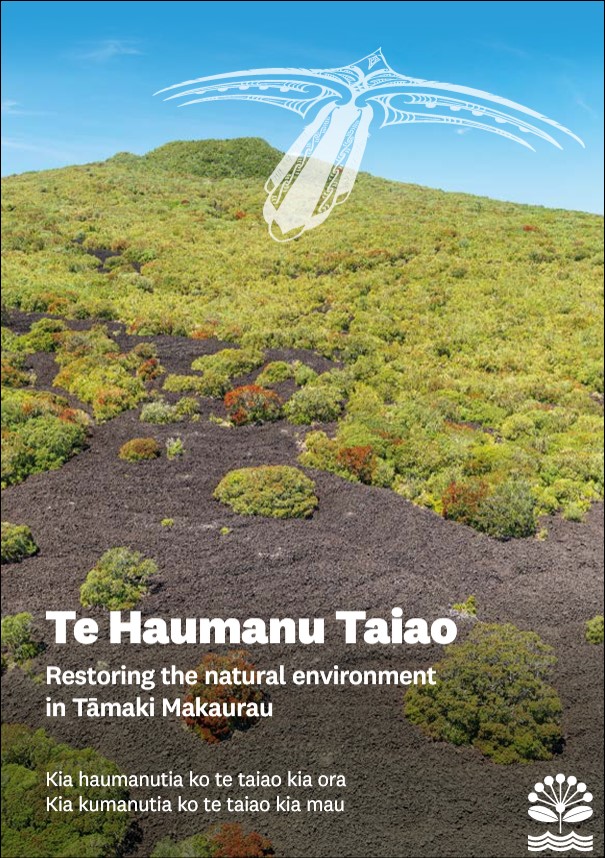Te haumanu taiao: Restoring the natural environment in Tāmaki Makaurau
Author:
Auckland Council, Ngā Iwi Mana Whenua o Tāmaki MakaurauSource:
Auckland Council, Ngā Iwi Mana Whenua o Tāmaki MakaurauPublication date:
2023Topics:
EnvironmentTe Tiriti o Waitangi partnership statement
Te Tiriti o Waitangi (The Treaty of Waitangi) provides the high-level context for the unique relationship between Te Kaunihera o Tāmaki Makaurau (the Auckland Council) and Ngā Iwi Mana Whenua o Tāmaki Makaurau.
Te Kaunihera o Tāmaki Makaurau and Ngā Iwi Mana Whenua o Tāmaki Makaurau acknowledge the unique partnership relationship founded on Te Tiriti o Waitangi. In the design and implementation of ecological restoration projects consideration must be given to determine how to give effect to Te Tiriti o Waitangi.
Note: For the purpose of Te Haumanu Taiao: Restoring the natural environment in Tāmaki Makaurau, the term 'Ngā Iwi Mana Whenua o Tāmaki Makaurau' refers to the nineteen iwi of the greater Auckland region and recognises that each iwi is wholly autonomous, individual and unique.
The information provided in this resource, does not seek to reflect comprehensively the values and principles of individual Iwi Mana Whenua o Tāmaki Makaurau. The mana, mana motuhake, and tino rangatiratanga of each iwi is in no way undermined, constrained or obligated by the contents of Te Haumanu Taiao: Restoring the natural environment in Tāmaki Makaurau.
Extracts:
Ngā Iwi Mana Whenua o Tāmaki Makaurau, who have participated in the development of this guide, invite you to partner with them to bring balance back to the whenua. From the mihimihi at the front of Te Haumanu Taiao: Restoring the natural environment in Tāmaki Makaurau, you will be ushered along a journey of restoration and enlightenment that draws on the heart of Te Ao Māori and the narratives of our primal ancestors Ranginui and Papatūānuku.
1. Ngā Whakaaro o Ngā Iwi Mana Whenua o Tāmaki Makaurau ki te Haumanutanga: Mana whenua perspectives on restoration
1.1 Whakapapa o te Taiao/o te Ao Turoa
Maiea te mauri nō tuawhakarere We call upon the force from time immemorial The journey through the narrative of whakapapa is a central part of our very existence, our lineage, our genealogy that links us today to our primal ancestors at the very beginning of time. Whakapapa binds the spiritual to the natural and the inanimate to the animate.
The journey through the narrative of whakapapa is a central part of our very existence, our lineage, our genealogy that links us today to our primal ancestors at the very beginning of time. Whakapapa binds the spiritual to the natural and the inanimate to the animate.
Our story upholds these connections of the spiritual and physical realms. From the union of Ranginui and Papatūānuku begat the natural world – Te Taiao first and Te Ira tangata later. Sharing whakapapa with the natural world consolidates our inter-reliance and interdependence with nature, all things – people, birds, fish, birds, and weather patterns are members of the same family, with us as tēina.
In essence, whakapapa is a system that guides our behaviour, sense of belonging and responsibilities. Our collective responsibility is to protect and preserve whole living systems, to ensure we maintain, sustain, and assist the regeneration of the whakapapa relationships that enable the wellbeing of these systems. ...
2. What is ecological restoration?
Kia haumanutia ko te taiao kia ora
May the environment be restored to total health
2.1 Technical understandings of ecological restoration
Ecological restoration (or simply restoration) is generally described as assisting the recovery of ecosystems that have been damaged, degraded, destroyed, or disturbed by human activities1. Restoration includes activities to protect and improve existing ecosystems as well as recreating ecosystems that have been lost.
An ecosystem is a collection of species that interact with each other and their supporting environment. Thirty-six naturally occurring terrestrial (land-based) and wetland ecosystem types have been identified in Tāmaki Makaurau / Auckland, distinguished by different environmental conditions and species assemblages. They include forests, cliffs, regenerating scrub, freshwater wetlands, coastal wetlands, caves, and geothermal areas. ...
Auckland Council, September 2023
See also
Tiaki Tāmaki Makaurau Conservation Auckland
Te Haumanu Taiao: Restoring the natural environment in Tāmaki Makaurau
The purpose of this guide is to empower anyone undertaking restoration in Tāmaki Makaurau / Auckland to achieve their ecological restoration goals and to further enable the biodiversity of our region to heal and flourish.
This resource was created in partnership with Ngā Iwi Mana Whenua o Tāmaki Makaurau and includes their perspectives on restoration including kaitiakitanga, prioritising the practices of local tribal authorities to uphold ‘Te Mana o te Taiao’ and guidance on engaging with mana whenua.
Te Haumanu Taiao supports Aucklanders to achieve their ecological restoration goals and to further enable the indigenous biodiversity of our region to heal and flourish. Restoration projects, whether they cover 100 square metres or 100 hectares, are critical to retaining and extending the native environment across our region. Te Haumanu Taiao complements the Indigenous terrestrial and wetland ecosystems of Auckland that describes the terrestrial and wetland ecosystems occurring in the Auckland region and the restoration guide provides guidance on restoring each of these ecosystems.
The objectives of this resource are to provide:
- guidance on how to maximise and measure ecological outcomes of a restoration project
- current best practice methods for common forms of restoration in Tāmaki Makaurau / Auckland
- ecosystem-specific guidance to restore specific terrestrial, wetland, and riparian ecosystem types
- cultural perspectives on the maximisation and measurement of Māori outcomes of a restoration project
The resource has no formal regulatory status but provides best practice guidance for restoration projects and conservation planting that may be required as part of resource consent processes in the Tāmaki Makaurau / Auckland region. Please refer all resource consent related queries back to the main Auckland Council website.
